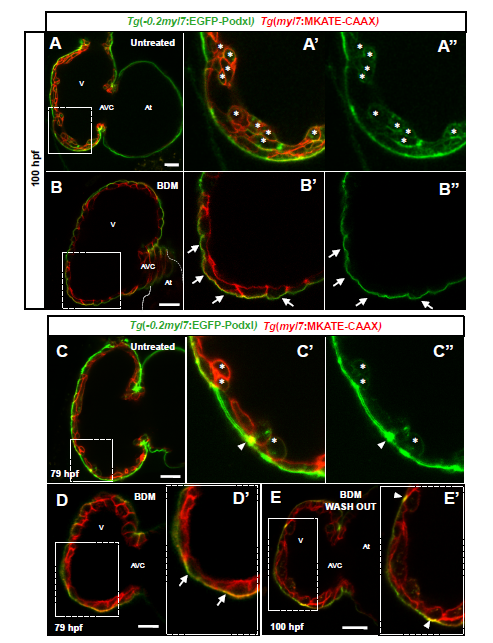Fig. S2
Apical constriction is recovered after restoring blood flow in larval zebrafish hearts
(A-B'') Confocal images (mid-sagittal sections) of 100 hpf Tg(-0.2myl7:EGFP-podxl);Tg(myl7:MKATE-CAAX) zebrafish hearts after 20 mM BDM treatment. Boxed area in A shown in A' and A''. Untreated larvae at 100 hpf showing depolarized cardiomyocytes (A' and A'', asterisks). Boxed area in B shown in B' and B''. Larvae were treated at 56 hpf and imaged at 100 hpf. BDM-treated larvae did not exhibit any apical constriction or depolarized cardiomyocytes (B' and B'', arrows). (C-E') Confocal images (mid-sagittal sections) of 79 hpf Tg(-0.2myl7:EGFPpodxl); Tg(myl7:MKATE-CAAX) zebrafish hearts after 20 mM BDM treatment. Boxed area in C shown in C' and C''. Untreated larvae at 79 hpf showing apical constriction (C' and C'', arrowheads) and depolarized cardiomyocytes (C' and C'', asterisks). Boxed area in D shown in D'. Larvae were treated at 72 hpf and imaged at 79 hpf. After 7 hours of treatment, larvae did not exhibit any apical constriction or depolarized cardiomyocyte (D', arrows). Boxed area in E shown in E'. At 79 hpf, BDM was removed and washed out, and larvae were then imaged at 96 hpf. Imaging reveals presence of apical constrictions (E', arrowheads). At, atrium; V, ventricle; AVC, atrioventricular canal. Scale bars, 20 μm.

